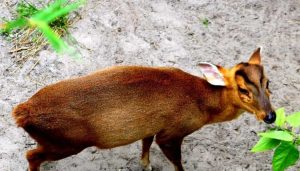Leaf muntjac (Muntiacus mutagenesis) is a small, forest-dwelling deer species found in the subtropical and tropical forests of Southeast Asia.
In this article, we explore the leaf muntjac’s natural range and distribution, the characteristics of its habitats, and the threats it faces due to human activities. We also discuss conservation efforts to protect this unique and vulnerable species.
Leaf Muntjac’s Natural Range And Distribution

Leaf muntjac is native to the mountainous regions of northern Myanmar and Yunnan Province in China. It is also found in the Putao National Park and Hponkanrazi Wildlife Sanctuary in Myanmar. The species is known to inhabit subtropical and tropical forests, as well as bamboo thickets and grasslands.
Characteristics Of Leaf Muntjac Habitats
Leaf muntjac’s habitats are characterized by dense vegetation and high canopy cover. They prefer to live in areas with abundant vegetation cover, which provides both food and cover from predators.
Leaf muntjac is also known to inhabit areas with steep slopes and rocky terrain, which provides natural shelter and protection from predators.
Geographic And Environmental Factors Affecting Leaf Muntjac Distribution
Leaf muntjac’s distribution is influenced by several geographic and environmental factors. These include elevation, temperature, precipitation, and vegetation cover.
For instance, leaf muntjac is found at elevations ranging from 900 to 3,400 meters above sea level. The species is also known to inhabit areas with a mean annual temperature of 15 to 25 degrees Celsius, and a mean annual rainfall of 1,000 to 3,000 millimeters.
Leaf Muntjac Population Trends And Conservation Efforts
Leaf muntjac is classified as a vulnerable species by the International Union for Conservation of Nature (IUCN). The species is threatened by habitat loss due to human activities such as deforestation, mining, and agriculture.
Other threats include hunting for meat and medicinal use, as well as competition for resources with other deer species. To protect leaf muntjac and its habitat, conservation efforts are underway, including establishing protected areas, habitat restoration, and law enforcement to curb illegal hunting and poaching.
Leaf Muntjac Habitat Requirements And Preferences

Leaf muntjac’s habitat requirements and preferences include diverse understory vegetation, a closed canopy cover, and access to water.
The species is also known to prefer areas with a mix of grasslands, bamboo thickets, and deciduous and evergreen forests. The availability of food sources such as fruits, leaves, and grasses also influences leaf muntjac’s habitat preferences.
Leaf Muntjac Adaptations To İts Habitat
Leaf muntjac has several adaptations that allow it to survive in its habitat. These include its small size and agile body, which allow it to navigate through dense vegetation and rocky terrain.
The species is also known to be a good swimmer, which helps it cross rivers and streams. Additionally, leaf muntjac has a cryptic coloration that allows it to blend in with its surroundings, making it difficult to spot predators.
Threats To Leaf Muntjac Habitats And Their İmpact On The Distribution
Human activities such as deforestation, mining, and agriculture are major threats to leaf muntjac’s habitats. These activities destroy the species’ habitat and fragment it, making it difficult for leaf muntjac populations to survive.
Hunting and poaching for meat and medicinal use also have a significant impact on leaf muntjac populations, reducing their numbers and disrupting their social behavior. Competition for resources with other deer species is another threat that can affect leaf muntjac’s distribution.
Leaf Muntjac And İts Relationship With Other Species İn İts Habitat
Leaf muntjac has a mutualistic relationship with several plant species in its habitat. For instance, the species helps to disperse the seeds of some plant species by consuming their fruits and excreting the seeds.
Leaf muntjac is also an important prey species for several predators, including leopards, tigers, and pythons. Its presence in the ecosystem contributes to the overall biodiversity and functioning of the forest ecosystem.
In conclusion, the leaf muntjac’s natural range and distribution, the characteristics of its habitats, and the threats it faces due to human activities are important considerations for the conservation of this unique and vulnerable species. Efforts to protect leaf muntjac and its habitat through conservation measures are necessary to ensure the survival of this important species and the ecosystems it inhabits.










